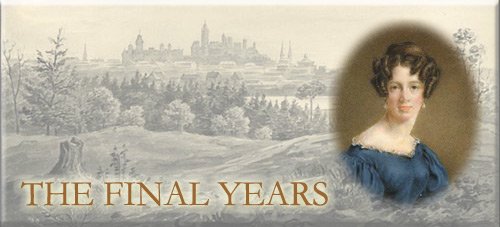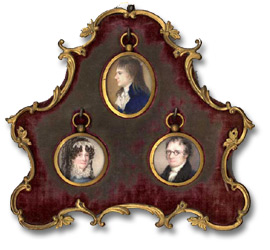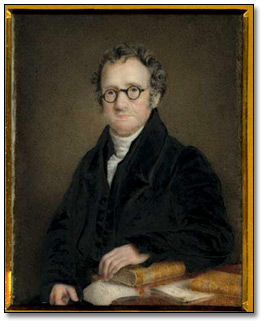
Table of Contents
Home | The Early Years | The Grand Tour | The Grand Tour- Continued
Britain - 1821-1837 | Miniatures on Ivory | Emigration - 1837
Settlement - 1837-1852 | Settlement - Continued | Peterborough and Toronto - 1852-1859
Britain & Canada: Tours and Vacations - 1860-1864 | Britain & Canada -1865-1878
Niagara, Ottawa, and Toronto - 1870s, 1880s
The Final Years | Langton Family and Family Connections | Preserving of the Collection
Resources and Acknowledgements
In their retirement years, the Langton family resided in Toronto, first at 23 Prince Arthur Avenue (1878-1885) in Yorkville, which, coincidentally, is now the national headquarters of the Women's Art Association of Canada. |
||
Langton spent these years happily
writing and painting china. These activities must have become
increasingly important to her over the years as her hearing impairment
had rapidly become more severe from the mid-1860s onwards. In 1880, at the age of 76 she made her final return trip to England (a "short" one for her, lasting but six months!), accompanying her youngest "Canadian" nephew, Hugh Hornby Langton on his first visit to England. They toured many of her old familiar haunts, including the beloved Blythe Hall. In 1885 the Langtons made their final move, this time to 123 Beverley Street: another artistic connection, as this house was situated on the edge of the property that is now home to the Art Gallery of Ontario. |
|
|
|
Also in 1885 John Langton, in a letter to Thomas Need, wrote: "[My family] are well, including my sister who[,] now in her 82nd year[,] is as industrious as ever, painting from morning to night" (John Langton to Thomas Need, August 1885, AO, Thomas Need Papers). |
||
| During the last nine years of her life - her "sketching rambles" now over - she painted almost exclusively at home, on items of fine china. The inventory of the pieces that she hand decorated in this period lists more than three hundred items; most destined as gifts to family members and close friends; some were executed for sale at charitable events, such as bazaars in aid of churches in Toronto, Peterborough, Lindsay. Only a dozen or so specimens of her china painting have come to light. |
||
|
Anne died in the Beverly Street house in 1893, a month before her eighty-ninth birthday; John in 1894. They, along with Lydia, John's wife and each of John and Lydia's children and their spouses, are buried in the family plot in St. James' cemetery, overlooking the Rosedale ravine. Anne Langton's body of art work is a tribute to her artistic talents and to her indefatigable dedication to fine art, as well as to her personal vision of life in the New World. Had she chosen to make her living as an artist - in England, at least - her talent would have stood her in good stead. In addition, her writings are a lively testimony to this remarkable woman's strength of character, her psychological resilience in the face of sometimes overwhelming odds, her devotion to others (in both family and community) and, not least, to her engaging wit and deft self mockery. |
|
Anne Langton left behind a rich legacy through which future generations of Canadians can trace some of their early cultural roots. Her consistent and extensive artistic output, over almost six decades, appears to be a unique documentary record in early Canadian art by women. Anne apparently died content and creatively fulfilled, much-loved and appreciated by her family. Hugh Hornby Langton, who would edit her journals and letters for publication in 1950 as "A Gentlewoman in Upper Canada", was appointed Chief Librarian at the University of Toronto just one year before his aunt's death, thus continuing the family's links to that institution and to the city. |
||
|
Hugh Hornby Langton penned this epitaph to his beloved aunt: |
||
|
||
Fortunately, Langton's body of work has survived, preserved first by her family, now mostly by public institutions. Her visual art and life writing offer an intelligent, sensitive account of a crucial period in Canada's early social history. In some ways, it parallels accounts by other early European settlers in North America (and in other former British colonies), including her noted contemporaries, and near-contemporaries, visitors and/or settlers: Elizabeth Simcoe, Anna Jameson, Mary O'Brien, Jane Ellice, Catharine Parr Traill, Susanna Moodie, Juliana Horatia Ewing. The influence of Langton's legacy can now extend well beyond her life span, enabling her cultural descendants to appreciate their origins more fully. Her "usefulness" continues: countless generations can access her visual images and verbal sketches and the era which they evoke, thanks to state-of-the-art curatorship in such institutions as the Archives of Ontario. |
|
|
The Early Years | The Grand Tour | The Grand Tour- Continued
Britain - 1821-1837 | Miniatures on Ivory | Emigration - 1837
Settlement - 1837-1852 | Settlement - Continued | Peterborough and Toronto - 1852-1859
Britain & Canada: Tours and Vacations - 1860-1864 | Britain & Canada -1865-1878
Niagara, Ottawa, and Toronto - 1870s, 1880s
The Final Years | Langton Family and Family Connections | Preserving of the Collection
![Anne Langton late in life (detail), [ca. 1890]](pics/11268_anne_photo.jpg)

